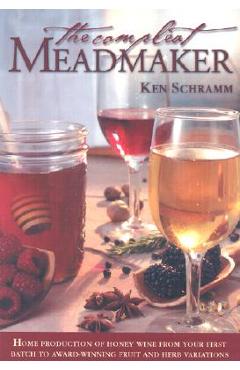The Compleat Meadmaker: Home Production of Honey Wine from Your First Batch to Award-Winning Fruit and Herb Variations - Ken Schramm

Detalii The Compleat Meadmaker: Home Production
The Compleat Meadmaker: Home Production - Disponibil la libris.ro
Pe YEO găsești The Compleat Meadmaker: Home Production de la Ken Schramm, în categoria Cooking.
Indiferent de nevoile tale, The Compleat Meadmaker: Home Production of Honey Wine from Your First Batch to Award-Winning Fruit and Herb Variations - Ken Schramm din categoria Cooking îți poate aduce un echilibru perfect între calitate și preț, cu avantaje practice și moderne.
Preț: 111.32 Lei
Caracteristicile produsului The Compleat Meadmaker: Home Production
- Brand: Ken Schramm
- Categoria: Cooking
- Magazin: libris.ro
- Ultima actualizare: 11-04-2024 01:14:23
Comandă The Compleat Meadmaker: Home Production Online, Simplu și Rapid
Prin intermediul platformei YEO, poți comanda The Compleat Meadmaker: Home Production de la libris.ro rapid și în siguranță. Bucură-te de o experiență de cumpărături online optimizată și descoperă cele mai bune oferte actualizate constant.
Descriere magazin:
Since The Compleat Meadmaker was first published, mead has continued to grow in popularity as crafted beverages have become an established part of the beverage market in America. In 2003 there were roughly 60 commercial meaderies in the US, but by 2020 this number stood at 450. Naturally, many hobbyists are also discovering the delights of making this nectar of the gods themselves. Thanks to the global distribution of bees and, therefore, honey, you will find mead-like drinks in virtually every corner of the world. No wonder historians recognize it as one of humankind\'s oldest fermented beverages. Mead production never really ceased in Europe and Africa, but its star was eclipsed with the increasing production and distribution of wine, beer, and distilled spirits from the 1600s onward. With the rebirth of brewing and the establishment of world-class wine producing regions in the US, it is time for mead in the twenty-first century to be brought back into the limelight. Mead needs to establish a vocabulary of its own and find a place in the hearts of homebrewers and home winemakers. In The Compleat Meadmaker, veteran meadmaker Ken Schramm--one of the founders of the Mazer Cup Mead Competition, North America\'s oldest mead-only competition--introduces the novice to the wonders of mead. With easy-to-follow procedures and simple recipes, he shows how you can quickly and painlessly make your own mead at home. In later chapters, Schramm introduces flavorful variations on the basic theme that lead to meads flavored with spice, fruits, grapes, and malt. The author covers the many aspects of meadmaking in a comprehensive but easy-to-read fashion, with something for novices and experienced brewers and vintners alike from basic equipment for meadmaking, creating your first must, and on through the basics of fermentation, racking, and bottling. Once the first steps have been taken Schramm goes into more detail, involving balancing for taste using acid, priming for sparkling mead, corking practices, and strategies for clarifying. He also covers aspects of fermentation, such as selecting the right yeast strain, aerating and managing the pH of your must during the critical early phase of fermentation, and adjusting nutrient levels to suit mead fermentation. The author also troubleshoots common problems and processes, such as stuck fermentations, fermentations that will not start, slow or prolonged fermentations, measuring total acidity via acid titrations, and on bal

Produse asemănătoare
Produse marca Ken Schramm

The Compleat Meadmaker: Home Production of Honey Wine from Your First Batch to Award-Winning Fruit and Herb Variations - Ken Schramm
![]() libris.ro
libris.ro
Actualizat in 11/04/2024
111.32 Lei